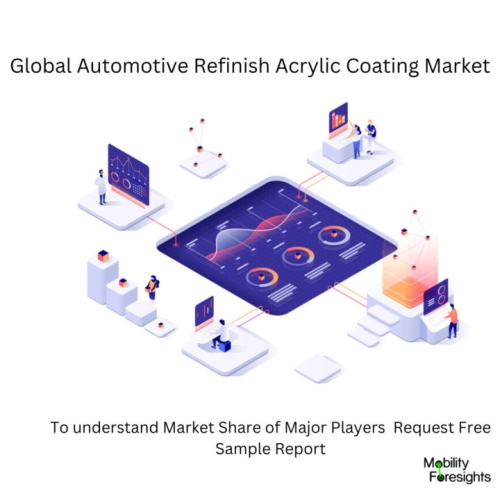
- Get in Touch with Us

Last Updated: Apr 25, 2025 | Study Period: 2023-2030
The method of acrylic coating, which uses the premium paint sealant acrylic II to provide all varieties of automobile paint finishes a long-lasting, high gloss shine, is particularly effective at protecting the outside paint of cars.
One of the most popular types of conformal coatings utilised nowadays is acrylic resin (AR). The coatings are made of a single component, namely pre-formed acrylic polymers that are dissolved in a solvent and applied to surfaces.
These paints have a substantial body basis that makes them survive longer than paints with an enamel or lacquer base. These paints are typically used on engine parts and other surfaces that experience high temperatures.
Auto paint comes in two varieties: solventborne and waterborne. Both paint kinds can be applied to cars, but they differ in the substance used to create them. Traditional auto paints that have been in use for a long time are solventborne paints.
Acrylic paint's binder, acrylic polymer, forms a film once the water has evaporated. The term "vehicle" describes the area of paint that contains the pigment and binder. Water-based acrylic is transported by water, and when it mixes with the binder, it forms a polymer emulsion.
None of the acrylic paints are entirely waterproof. By using a prepared surface, you can increase the paint's water resistance. choosing a paint brand that is appropriate. After the paint has dried, varnishing the surface is also crucial.

The Global Automotive Refinish Acrylic Coating market accounted for $XX Billion in 2022 and is anticipated to reach $XX Billion by 2030, registering a CAGR of XX% from 2023 to 2030.
The BASF Coatings Business Unit has introduced a fresh and cutting-edge line of refinish paints as a pioneer in water-based coating solutions for the automobile sector.
This product line can greatly minimise environmental impact while increasing efficiency, fully satisfying the demands of contemporary auto repair shops. During the development phase, this water-based paint product put a strong emphasis on sustainable development.
It uses cutting-edge formulae to maximise process performance, achieves quick and effective application, helps technicians increase spraying effectiveness, and also satisfies the environmental advantages of refinishing paint.
With a volatile organic compound (VOC) level of less than 250 g/l, the new product series is one of the most environmentally friendly automobile refinish products and helps repair facilities minimise operation time to reduce carbon dioxide emissions.
All of our business endeavours are customer-focused, and we are dedicated to creating the best solutions based on client input. Customers and I work together to test how well items perform in real-world settings.
Performance demonstrates that the spray system can accurately replicate the millions of hues that are currently available on the market in any climate.
| Sl no | Topic |
| 1 | Market Segmentation |
| 2 | Scope of the report |
| 3 | Abbreviations |
| 4 | Research Methodology |
| 5 | Executive Summary |
| 6 | Introduction |
| 7 | Insights from Industry stakeholders |
| 8 | Cost breakdown of Product by sub-components and average profit margin |
| 9 | Disruptive innovation in the Industry |
| 10 | Technology trends in the Industry |
| 11 | Consumer trends in the industry |
| 12 | Recent Production Milestones |
| 13 | Component Manufacturing in US, EU and China |
| 14 | COVID-19 impact on overall market |
| 15 | COVID-19 impact on Production of components |
| 16 | COVID-19 impact on Point of sale |
| 17 | Market Segmentation, Dynamics and Forecast by Geography, 2023-2030 |
| 18 | Market Segmentation, Dynamics and Forecast by Product Type, 2023-2030 |
| 19 | Market Segmentation, Dynamics and Forecast by Application, 2023-2030 |
| 20 | Market Segmentation, Dynamics and Forecast by End use, 2023-2030 |
| 21 | Product installation rate by OEM, 2023 |
| 22 | Incline/Decline in Average B-2-B selling price in past 5 years |
| 23 | Competition from substitute products |
| 24 | Gross margin and average profitability of suppliers |
| 25 | New product development in past 12 months |
| 26 | M&A in past 12 months |
| 27 | Growth strategy of leading players |
| 28 | Market share of vendors, 2023 |
| 29 | Company Profiles |
| 30 | Unmet needs and opportunity for new suppliers |
| 31 | Conclusion |
| 32 | Appendix |